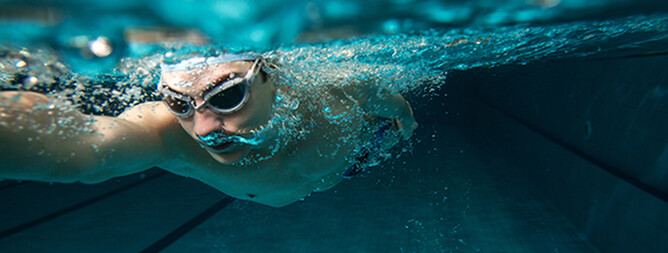Plugging the tech gap for swimmers
It won’t have escaped any triathlete that training in the pool lacks the immediate feedback that technology can provide when running or cycling.
“Real time feedback for athletes is really helpful for a number of reasons,” said Amit Katwala, author of The Athletic Brain. “When you are pushing at the edge of your ability to improve performance and get ‘in the zone’ it’s the real-time feedback that is crucial for an athlete to see the impact in the moment.”
So it’s welcome news that wearable tech for the pool, is finally catching up and smartglasses are being adapted to meet exactly this need.
Several years ago, the team at The Imagination Factory recognised that swimming presented this kind of opportunity and started work on a solution.
Reconnecting with time underwater
"I love triathlon,” said one of the SwimAR co-creators, Julian Swan, “but when I was pool training I felt disconnected from a sense of time. The feedback that kept me powering through in other disciplines was missing from my swim.”
“As a product designer,” Julian continues, “I knew there was a solution, so I spoke with the team and we set about testing different technologies.”
SONY’s SmartEyeglass technology has given us what we consider the very best application for real-time feedback in the pool.
It gives swimmers real-time performance data, displayed in front of their eyes. SwimAR can be attached to regular training goggles, without obstructing your field of view. It looks like this (below) only brighter and clearer.
Overcoming swim brain
“I’ve tried out a prototype and it’s totally unobtrusive to swim with – the tech involved is amazing,” said Nici Cahusac, Age Group Triathlete and Medalist. “We all know how easy it is to lose concentration in the pool,” she continues.
“You just get swim brain sometimes on the longer swims; pounding the pool, length after length, only to get to the end of the session and find your pace dropped off many laps ago.”
“With multiple training sessions a week, my time in the pool has to be smart. I have a family and a job to deliver on, so by the time I get into the pool, I really want to know it’s going to count.”
From idea to product
“We have been through a two year development process,” said Mark Hester, technical lead and co-creator of SwimAR, “as part of our Factory Fridays initiative.”
“Now we are ready to push it out of the studio and into the hands of athletes, coaches and the toughest training camps around the world, so others can see how this technology can transform swim training.”
“We’ve developed prototypes, tested them and continue to remodel based on tester’s feedback, to deliver what we have learnt swimmers really want."
SwimAR’s features
- real-time performance data displayed in front of your eyes, without obstructing field of view
- lap counts
- stopwatch and split times
- distance swum
- light and hydrodynamic
- blue tooth for data transfer
- rechargeable battery and wireless charging base
Swim to pace without constant checks
“When I start teaching swimmers,” said Kat Berry, Coach with Challenge Tri Camp, “they often think the more effort they put in, the faster they'll go. But frequently, they just end up putting in a lot of effort without getting much faster. Their technique breaks down as they try to push themselves harder and they waste a lot of energy for minimal gain.”
“Then, when they relax and do an easier swim, they are surprised to find their times are actually similar to those with hard effort.”
“SwimAR is an exciting prospect,” Kat continues, “especially for longer distance athletes who are doing lengthy swims. You want them to swim to pace but not stop to check watches.”
Adapting in the moment
This sentiment was mirrored by Kevin MacArthur, Head Coach at Edinburgh#3 Triathlon Club and coach for the Triathlon Scotland Academy: “SwimAR will enable athletes to work on pacing, particularly for longer distance training sets and for race planning.“
“If I swim a 400m set I can check my average pace on my watch at the end of the set but then only analyse each length after leaving the pool. If my pace for each length is inconsistent I can't fix it.”
Swimming form
“When you are learning a new skill,” continues Amit of The Athletic Brain, “or applying a new technique it feels quite clunky.”
“It’s like when you learn to drive a car: it feels awkward putting your foot on the clutch, changing gear, remembering the mirror and the clutch control, at the same time. But before long you are not even thinking about it and when you don’t think about it you are smoother and faster.”
“When you start thinking about it you can become slower and amateur about it.”
“Swimming is all about style, it’s not just about moving your limbs as fast as you can. It’s not easy to tell how fast you are going without a timer. One of the things when you are training and learning new skills is immediate and instant feedback. If you are not getting feedback in the moment, it’s hard to calibrate your performance and you don’t know if what you are doing is working. You would modify your stroke and have no idea if it’s making a difference till you get out of the pool.”
“Tweaking it and being able to see straight away if it’s working or not – that would be powerful.”
To make sure you get updates and find out when SwimAR will be available, sign up here.





